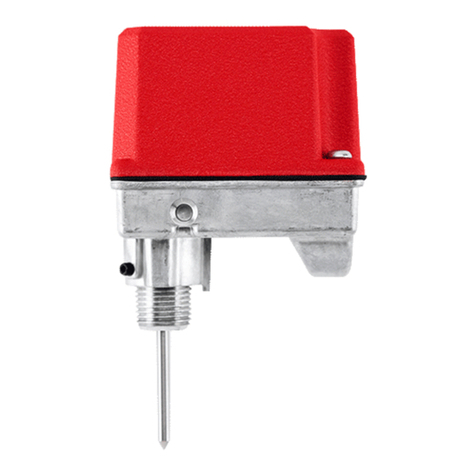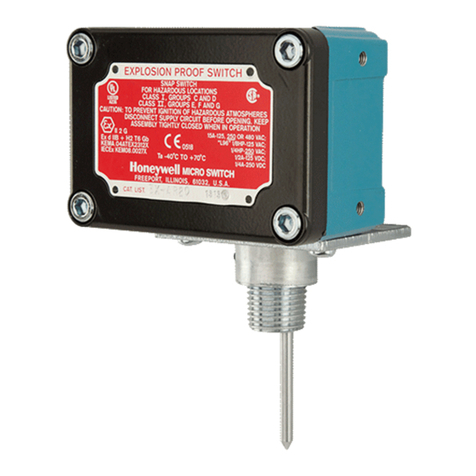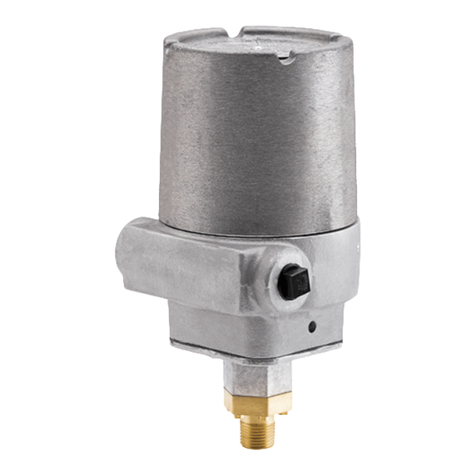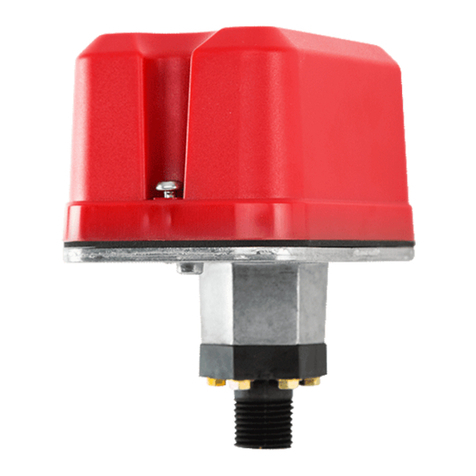
D770-25-00 3 I56-1427-000
Adjustments To Factory Settings
The EPS10EXP device is pre-adjusted at the factory to alarm
at 4–8 PSI on rising pressure (see Table 2). Pressure switch
settings may be adjusted in the field to obtain a different
pressure alarm response from 4 PSI to 20 PSI. The switch
has an override feature on the adjustment mechanism to
prevent exceeding the 20 PSI max. setting of the switch.
This override feature carries with it a tolerance band that
may limit the upper adjustment to 16–20 PSI. Care must be
used when setting the switch to ensure that the lower limit
of 4 PSI is not exceeded. This will allow the switch to reset
within the 3 PSI differential stated.
1. Install pressure switch as stated in “INSTALLATION”
portion of instruction manual. Attach pressure test
source to system.
2. Remove adjustment wheel cover and back off locking
screw (see Figure 1) to allow main adjustment wheel to
rotate freely.
3. Test trip point by slowly introducing pressure from the
pressure test source. When trip point is found, reduce
pressure to zero. Rotate main adjustment wheel (coun-
terclockwise to increase pressure) and retest until switch
trip point is at the desired pressure setting (4–20 PSI
range). Each tine on the wheel represents an approxi-
mate trip point change of 0.2 PSI. One full rotation
changes the trip point setting by approximately 2.5 PSI.
A reset differential of approximately 3 PSI is typical
throughout the entire adjustment range of switch.
4. Retest the set point several times to ensure accuracy of
setting.
5. Re-seat locking screw.
6. Re-install adjustment wheel cover.
Table 2.
NOTE: The sensor assembly is not field replaceable. Do
not attempt to disassemble these parts. If you have
any questions, consult System Sensor. System Sen-
sor recommends careful consideration of the fol-
lowing factors when specifying and installing
Alarm Pressure Switches. Always refer to the In-
stallation and Maintenance Instruction for specific
recommendations on individual devices before in-
stalling the unit.
• Electrical ratings stated in literature and on name-
plates should not be exceeded.
• Overload on switch can cause failure on the first
cycle. Always wire devices according to national and
local electrical codes.
• Install units away from shock and vibration. Proper
electrical fittings should be used to prevent moisture
from entering the enclosure via the conduit.
• Test all devices for proper operation after initial instal-
lation. Perform preventive maintenance and periodic
testing as required by the applicable NFPA standards
but not less than bi-monthly.
• Install a back-up control for all critical applications
where control failure could endanger life or property.
A backup control to serve as a high or low limit con-
trol is especially recommended for applications where
a runaway condition could result.
• Do not mount unit where ambient temperatures will
exceed published limits.
• Avoid impact or mechanical loading.
FACTORY SETTINGS (PSI)
MODEL Approx. Reset
EPS10EXP 4—8 3 PSI Diff.
Rise
Technical Manuals Online! - http://www.tech-man.com

























